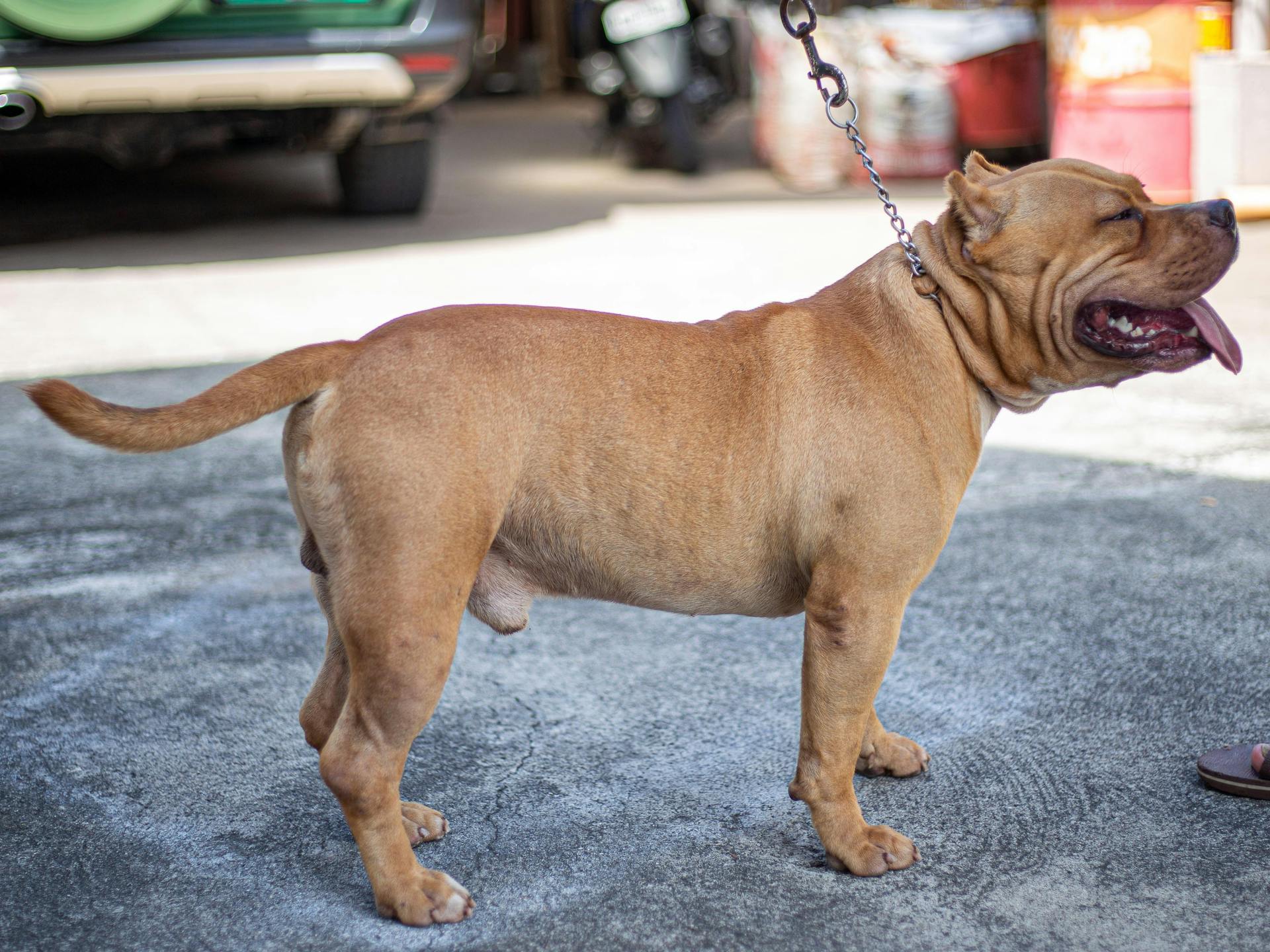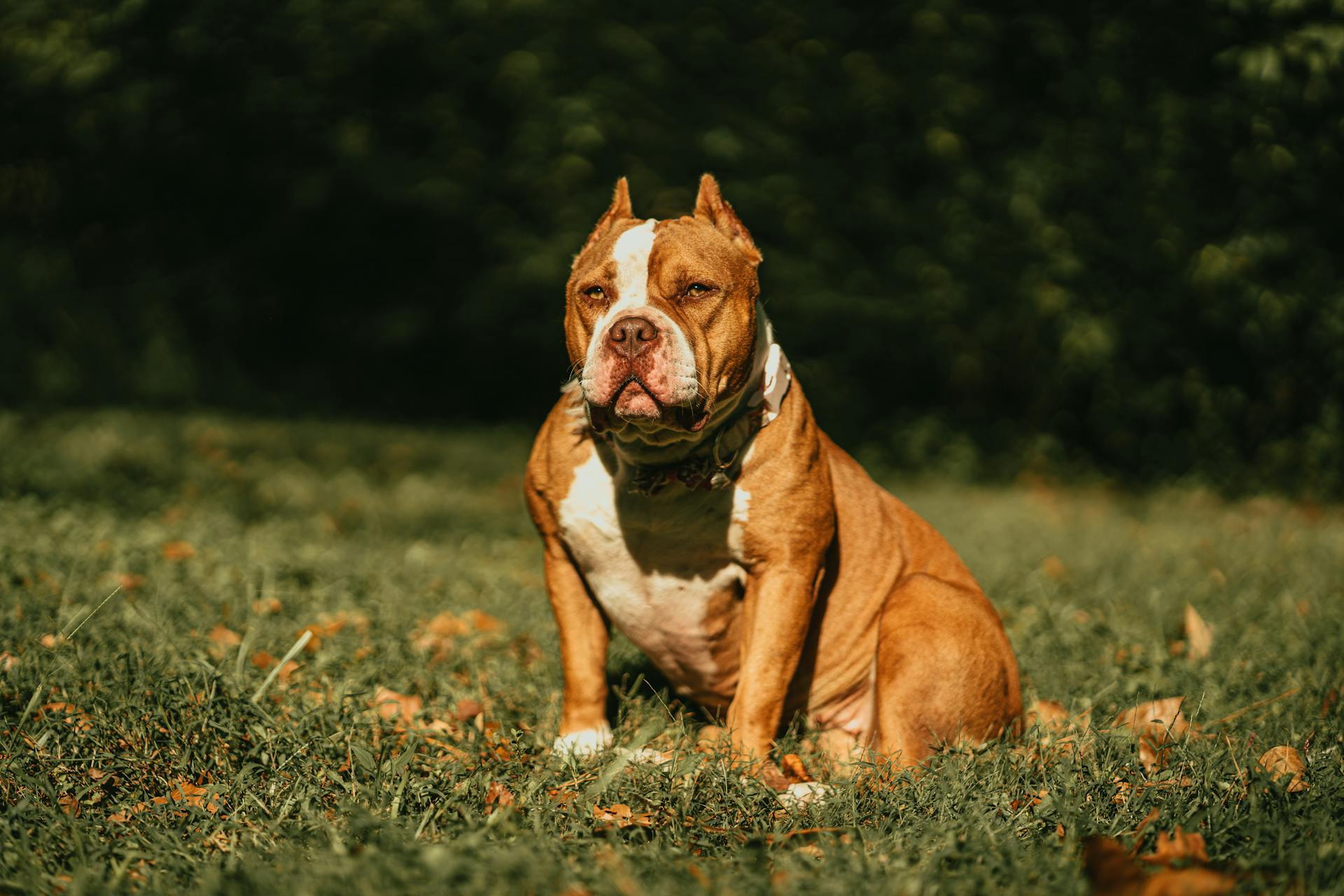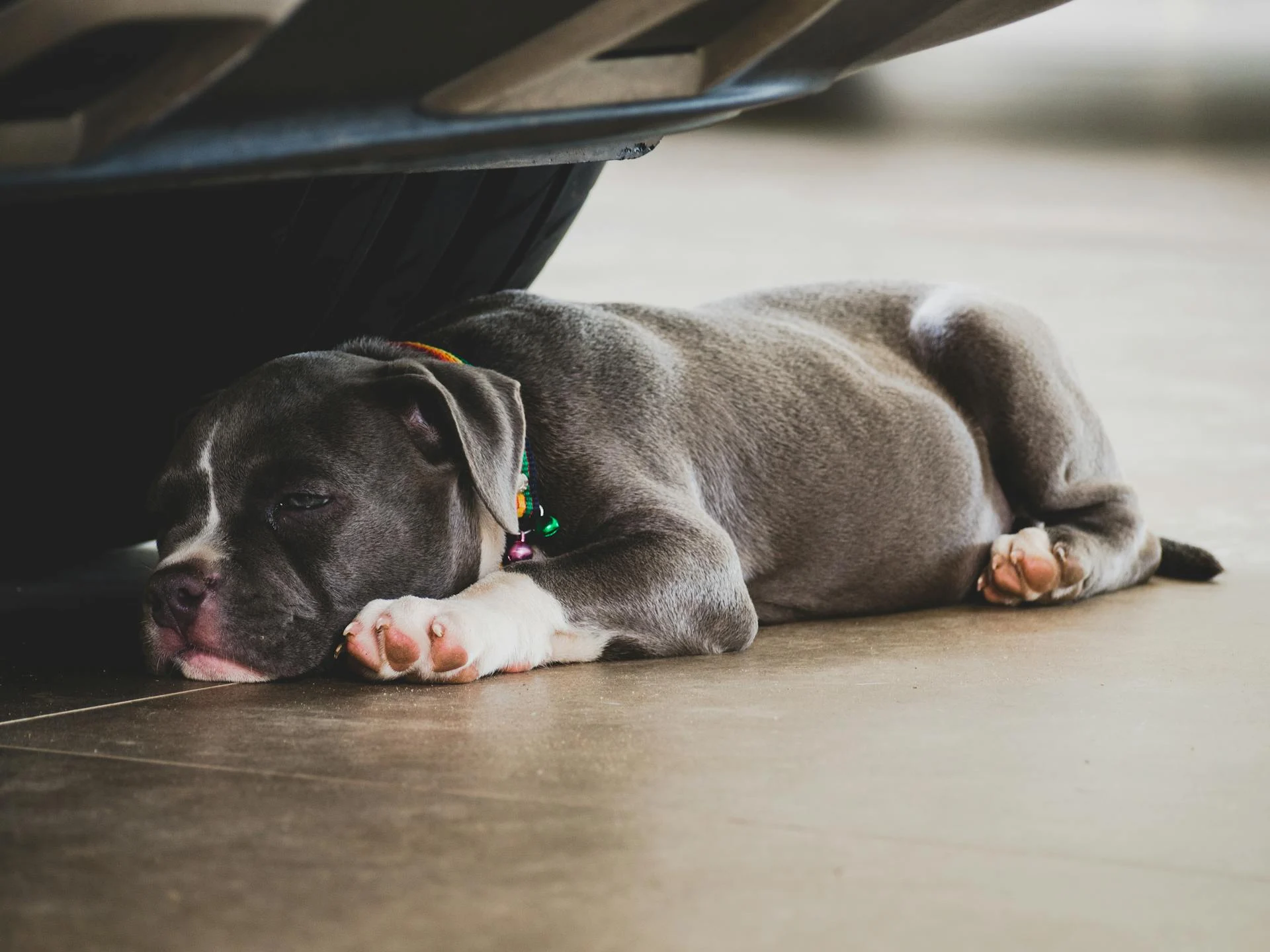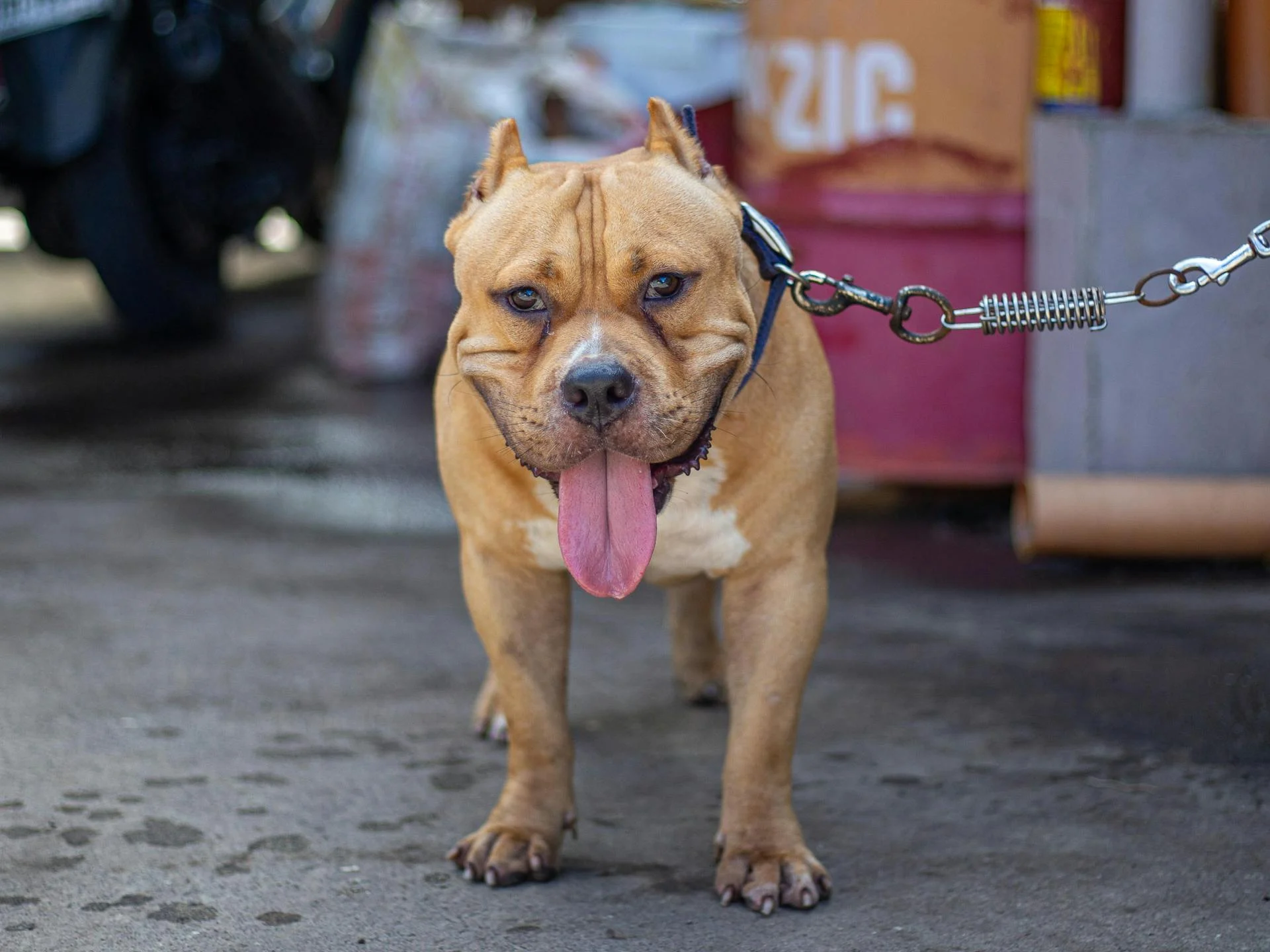
The American Bully male is a unique breed that requires attention to its exercise needs. They need regular exercise to maintain a healthy weight and prevent obesity.
To ensure they get enough physical activity, American Bully males should have at least 30 minutes of exercise per day, which can be broken down into shorter sessions.
Temperament and Behavior
The American Bully temperament is a sweet and loving nature that makes them an excellent family dog. They are highly adaptable and trainable, doing well in sports like weight pull and flirt pole.
One of the biggest misconceptions about American Bullies is that they are aggressive, but this is largely due to their physical resemblance to Pitbulls, which have a reputation for being aggressive. American Bullies were actually bred to remove these aggressive traits.
Despite their gentle nature, American Bullies can be very energetic and active, making them a great fit for families who enjoy outdoor activities. They are also very affectionate and kind with young children.
You might enjoy: Are American Bully Aggressive
In fact, American Bullies love to be around humans and will often show their love and affection through kisses and cuddles. They are not suitable as watchdogs or guard dogs, as they will happily show love to strangers rather than aggression.
With diligent training and responsible oversight, American Bullies can thrive as loving pets and even excel in dog sports. However, it's essential to remember that every dog is an individual, and some may display unexpected aggression, even towards family members.
Care and Maintenance
The American Bully is a powerful breed that requires regular exercise to keep them happy and healthy. They need a securely fenced yard where they can run around and play.
Bullies love to play with balls, but they're not driven to retrieve, so you won't need to worry about them bringing back sticks all day. They're particularly fond of games of tug and playing with flirt poles.
Given their strength, it's essential to engage them in activities that challenge both their body and mind, such as obedience and scent work. This will help keep them occupied and prevent destructive behavior.
Bullies are not natural swimmers and aren't very good at it, so it's best to stick to land-based activities. However, they can excel at dog sports like weight pulling, which is a great way to challenge them physically.
Coat care for American Bullies is minimal, consisting of occasional bathing and brushing. You'll need to brush them once a week to keep their coat looking its best.
Bullies don't like extreme temperatures, so it's essential to keep them indoors during hot or cold weather. Adults require a well-balanced and nutritious diet, but no special considerations beyond that.
Unfortunately, American Bullies are prone to hip dysplasia and elbow dysplasia, so it's crucial to feed them a large breed puppy food if you're raising a puppy. This will help slow down their growth rate and reduce the risk of developing these conditions.
It's also essential to have your puppy tested for pigment-related deafness, especially if they have a majority of white in their coat. This will ensure you're aware of any potential hearing issues early on.
Explore further: Smooth Coat Fox Terrier Puppies
Physical Characteristics
The American Bully male comes in three different sizes: pocket, standard, and giant. The standard size is the most common and is characterized by a muscular body with a compact, bulky build.
Males typically stand between 17 and 20 inches tall at the withers, while females are slightly shorter, ranging from 16 to 19 inches tall.
The American Bully's body is heavily muscled and massive, with a broad, deep chest and well-rounded ribs that create a barrel chest. The forelegs are set wide apart to permit chest development and are straight, sturdy, and muscular with large or round bones.
Here are the height ranges for American Bully males in different varieties:
Their tail is medium in length, low-set, and tapering to a fine point, extending approximately to the hock.
Characteristics of the Breed
The American Bully breed comes in three different sizes: pocket, standard, and giant. The standard size is a medium-sized dog with a compact, bulky muscular body.
Male American Bully dogs typically measure between 17 and 20 inches in height, while females range from 16 to 19 inches. The breed's heavy bone structure and blocky head are also defining characteristics.
The American Bully moves with a confident and proud attitude, and its gait should be effortless and powerful. The breed's front reach should be moderate and in balance with the rear.
Each leg of the American Bully should move in the same plane as the other leg on the same side, with minimal convergence. The backline should remain level, with only slight flexing.
A reputable breeder is essential when purchasing an American Bully puppy, as prices can range from $2000 to $5000.
Take a look at this: American Bully Back Leg Problems
XL
The XL type is determined by its adult height, with males measuring 21 to 23 inches (53 to 58 cm) at the withers.
Females fall within a slightly shorter range, measuring 19 to 22 inches (48 to 56 cm) at the withers.
Forequarters

The forequarters of a dog are a crucial aspect of its overall physical structure. They include the shoulders, upper arm, forelegs, and feet.
Shoulders should be strong and muscular, with wide blades set wide, and well laid back. The upper arm is approximately equal to the length of the shoulder blade and joined at an angle of approximately 35 to 45 degrees.
Forelegs should be straight, sturdy, and have large or round bones. Pasterns, the area below the elbow, are short and nearly erect.
Feet should be straight forward and of moderate size in proportion to the dog, compact, well arched, and tight.
Body
The American Bully's body is truly a sight to behold. They have a heavily muscled, massive, and bulky body type, which gives them a compact/medium length and a great deal of power for their size. This is a key element of breed type for the American Bully breed.
Their ribs are well-rounded, creating a barrel chest with all ribs close together, and their rib cage extends to the elbow or slightly below. This allows for a broad, deep, and well-filled chest that's not exaggerated to interfere with normal movement.
The forelegs are set rather wide apart to permit chest development, and their chest should be broad, deep, and well-filled in. The tail is medium in comparison to size, low set, tapering to a fine point, and extending approximately to the hock.
Here are the key features of the American Bully's body:
The American Bully's body is designed for power and agility, making them a formidable companion.
Health and Longevity
The American Bully male is a relatively new breed, but we've got some insight into potential health issues to watch out for. Cherry Eye is a common concern, where the gland under the third eyelid protrudes and looks like a cherry in the corner of the eye.
Regular vet checkups are crucial to catch these issues early on. Your vet may have to remove the gland in some cases.
Hip Dysplasia and Elbow Dysplasia are also potential problems, especially in large breed dogs. Hip Dysplasia occurs when the thighbone doesn't fit snugly into the hip joint, while Elbow Dysplasia can be caused by different growth rates and lead to lameness.
To minimize the risk of these health issues, it's essential to buy from a reputable breeder. This can greatly reduce the chances of your dog suffering from these conditions.
Discover more: Catahoula Leopard Dog Health Problems
Lifespan

The American Bully has a life expectancy between 10 and 13 years, on average.
This breed's relatively short lifespan means they need extra care and attention from a younger age to ensure they live a long and healthy life.
Their lifespan is comparable to other breeds of similar size and energy level, but with proper care they can still thrive and become beloved family members.
Regular exercise and a balanced diet can help American Bullies live up to their full potential and enjoy a happy, healthy life.
A different take: Life Expectancy in Pit Bulls
Known Health Issues
As you consider bringing an American Bully into your family, it's essential to be aware of the potential health issues that may arise. Cherry Eye is one of the most common health concerns in this breed, where the gland under the third eyelid protrudes and can be removed by a vet.
Hip Dysplasia is another issue that can affect American Bullies, causing the thighbone to not fit snugly into the hip joint. You may not notice any signs of discomfort in some dogs, but others may show pain and lameness on one or both rear legs.

Elbow Dysplasia is a common condition in large breed dogs, including American Bullies. It can be caused by different growth rates and can lead to lameness. Fortunately, it can be fixed with surgery.
Regular vet checkups and monitoring your dog's behavior are crucial to catching these issues before they become untreatable.
Nutrition and Exercise
For American Bully males, exercise is a must. Aim for 30 to 60 minutes of exercise per day, including walking and playtime.
American Bully's love to be outside and with their people, so incorporating family games into their exercise routine will keep them engaged and interested.
To ensure your American Bully is getting enough nutrients, feed them high-quality food specifically formulated for medium to large dog breeds.
Food and Diet
The food and diet of your American Bully is a crucial aspect of their overall health and well-being.
You'll want to make sure you're feeding them high-quality and nutritious food that's specifically formulated for medium to large dog breeds.

A good rule of thumb is to feed your American Bully 30 calories per pound of body weight.
Double check the back of the food packet for the exact feeding instructions based on your dog's weight.
Splitting your pup's meal into two meals a day is usually recommended.
This will help keep your dog's energy levels stable and prevent overeating.
You should always consult with your veterinarian for personalized feeding recommendations.
Exercise
Exercise is a crucial part of a Bully's daily routine. They need around 30 to 60 minutes of exercise per day, which can include walking and playing.
American Bullys love to be outside, so incorporating outdoor activities into their exercise regime is a great idea. This will also give them quality time with their family.
Exercise should be fun for your Bully, so try to include games with the family in their daily routine. This will make them more likely to get active and engaged.
For another approach, see: American Bully Family Dog
Family and Training
The American Bully male makes a fantastic family companion, being gentle around babies and sweet with children, making them the perfect playmate. They're also very loyal, which is one reason they make such good family pets.
They're happy to curl up next to you on the couch and watch TV, and they love showing affection with lots of licks and kisses. This breed doesn't require huge exercise needs, but they do best in a home with a large outdoor space. However, they can adapt to smaller homes and apartments as long as they have a place to go out and play.
Training the American Bully is relatively easy, as they generally pick up on commands quickly. Positive reinforcement training and reward-based training are the best approaches, using verbal praise and treats to encourage good behavior. Avoid punishing your Bully, as they won't understand and may become resistant to learning.
If this caught your attention, see: Family Shih Tzu
Family Compatibility
The American Bully is a loving and caring breed that makes an excellent family companion. They are particularly gentle around babies, so you won't need to worry about introducing them to the littlest member of the family.
Related reading: Are Pit Bulls a Good Family Dog

They are sweet with children but love to play with them too, making the perfect playmate. They like to show you how much they love you with lots of licks and kisses!
This dog is very loyal, which is one of the reasons they make such good family pets. They have moderate exercise requirements, but they do best in a home with a large space outside for them to play.
The American Bully gets on well with everyone, but they do need to be socialized from a young age so that they don't become scared when meeting new people.
Training
Training your American Bully is relatively easy because they tend to pick up on commands quickly. They thrive on positive reinforcement training, which means using verbal praise and treats to reward good behavior.
You should never punish your Bully because they won't understand what they did wrong and will become resistant to learning.
Start training your dog from a young age to help them become obedient and well-mannered.
Frequently Asked Questions
What 2 breeds make an American Bully?
The American Bully was developed by crossing the American Pit Bull Terrier and the American Staffordshire Terrier. These two breeds are key components in the creation of the American Bully.
Featured Images: pexels.com
